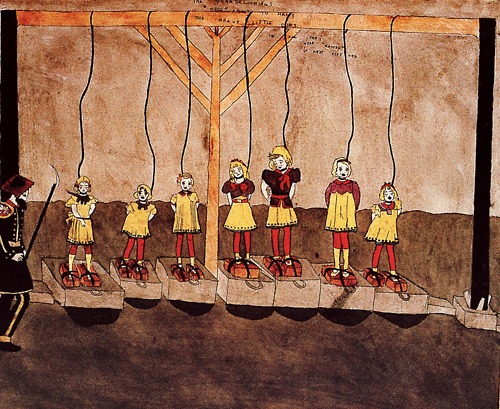Share This:
March 12, 2013 | Film,
In The Realms Of The Unreal

What would it feel like to spend 43 years inside a single room creating a 15,145 page book rich with illustrations, adventure and gruesome war scenes? How would it feel to continually toil over an artistic endeavor all but certain that you would never, ever receive feedback on the work let alone purposely let others experience it?
Henry Darger might be able to answer these questions but he is no longer available for questioning. In advance of ArtsEmerson’s screening of the documentary film about Darger and his work (In The Realms Of The Unreal, FRI MAR 15 @ 6PM & FRI MAR 22 @ 9PM in The Bright Family Screening Room) we have compiled a very brief summary of useful Darger-facts and some questions to keep in mind regarding these topics.
“The term outsider art was coined by art critic Roger Cardinal in 1972 as an English synonym for art brut, a label created by French artist Jean Dubuffet to describe art created outside the boundaries of official culture.” – Wikipedia entry on Outside Art
Henry Darger, Short Bio: Orphaned early in life, placed in an asylum for “feeble minded children” on account of either a) his excessive masturbation habits or b) the nearly unbelievably loaded quote “Little Henry’s heart is not in the right place.” Repeated attempts to escape the asylum, finally successful in 1908, witnesseses violent tornado that remains extremely important to him for the rest of his life. Besides a short time in the Army, Darger supports himself working as a custodian at a hospital, lives off meager wages, spends most time at church or his small apartment. Retires at age 62. Spends all available free time creating text and illustrations for a piece of fiction he titles In The Realms Of The Unreal. No one sees any of Realms until a few days before his death. Darger’s work becomes posthumously famous, sparks significant interest in the outsider art movement, his work becomes an inspiration to everyone from poets to punk bands. (Sources: In The Realms Of The Unreal, Wikipedia)
– A large sampling of Darger’s artwork.

Henry Darger’s infamous room.

Pop Culture Reverberations
– John Ashbery’s Girls On The Run

Girls on the Run is a long poem by the American writer John Ashbery, published in its own volume in 1999. The narrative centers on a group of girls known as the Vivians, who try to create an ideal world for themselves. The poem was inspired by the works of Henry Darger.
Excerpts:
Our phrase books began to feel useless‹for once
you have learned a language, what is there to do but forget it?
Each illustration changes us.
And now everyone must sleep.
The kiddies are silent for awhile,
And yes, singly or in pairs,
they come down to the water’s edge, to drink their fill. The wide-eyed pansies gaze
immutably. Rev up the old flivver, we’ll be disparate
for a time
and then we’ll see, the mice will see. Why all the fuss?
You know you came here just for this, this kiss, on the face, the dog said.
– The Vivian Girls

Vivian Girls is a punk rock trio named after the magnum opus of outsider author Henry Darger. They started in Brooklyn, NY in March 2007 with members Cassie Ramone (guitar/vocals); Katy “Kickball Katy” Goodman(bass/drums/vocals); and Frankie Rose (drums/bass/vocals).
Tell The World music video.
Questions:
– Do you imagine that outsider artists ever dream of the moment their work is finally discovered? Or is this lack of a need for an audience, in part, what makes them outsider artists?
– Is it less pure to wish that your art gets seen by others? Does this matter? Does intent matter? How important is self-awareness in an artist?
– Has there ever been an art genre that did not transform into a marketing strategy?
– Darger’s work contains reappropriations of commercialism (see his use of the Coppertone mascot as a model for his heroines) and post-modern styles such as writing himself into the narrative. Despite the fact that we can be certain that Darger had no idea that these elements were anything more than a means to a storytelling end, is it incorrect for the audience of a piece of outsider art to appreciate these pieces on other levels (even though these other level implications are purely accidental on the artist’s part)?
Please engage with us and share any thoughts that any of these questions bring to mind in the comments section of this entry. Enjoy the film!
Ryan Walsh is the External Affairs Coordinator for ArtsEmerson




Leave a Reply